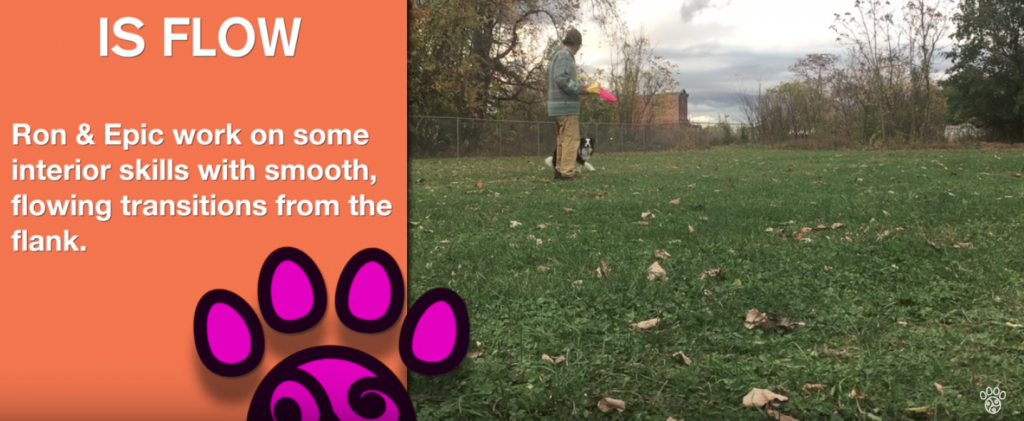
Epic Flatwork is Flow
Giz Gaz Warmup
A Giz Gaz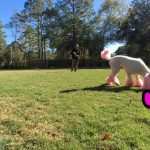 The Giz Gaz is like the opposite of a Zig Zag. A Zig Zag moves agressively in a straight line from left to right and right to left (clock and counter) in front... More is kind of the anti-Zig Zag. The Zig Zag
The Giz Gaz is like the opposite of a Zig Zag. A Zig Zag moves agressively in a straight line from left to right and right to left (clock and counter) in front... More is kind of the anti-Zig Zag. The Zig Zag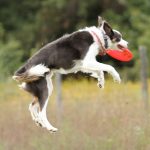 A Zig Zag is a series of catches in smooth succession that forces the dog to move back and forth across the field. Usually performed at a distance of 8-20 yards, the Zig... More features a sharp, aggressive reorientation to the disc, most always towards the handler. The Giz Gaz is a Rear Cross
A Zig Zag is a series of catches in smooth succession that forces the dog to move back and forth across the field. Usually performed at a distance of 8-20 yards, the Zig... More features a sharp, aggressive reorientation to the disc, most always towards the handler. The Giz Gaz is a Rear Cross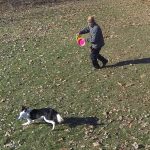 On a Rear Cross, the dog switches Flanks with the behind her. From clock to counter clockwise Flank or vice versa. Taken directly from the canine agility world, the Rear Cross is a... More in both directions with a Working Flank
On a Rear Cross, the dog switches Flanks with the behind her. From clock to counter clockwise Flank or vice versa. Taken directly from the canine agility world, the Rear Cross is a... More in both directions with a Working Flank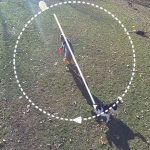 The Working Flank is a moving position. On a Working Flank the dog is out to your side some distance and holds position, moving with you as you move around the field. The... More in between. The dog works the flank with then peels off, turning away from and releasing the handler and the disc, in both directions.
The Working Flank is a moving position. On a Working Flank the dog is out to your side some distance and holds position, moving with you as you move around the field. The... More in between. The dog works the flank with then peels off, turning away from and releasing the handler and the disc, in both directions.
It’s one of my very favorite skills.
One of the main goals of these Flatwork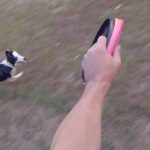 Flatwork is the stuff that happens between the catches. How the team moves and transitions, often without the disc, is flatwork. Flatwork concepts in disc dog are taken from the agility and herding... More sessions with Epic and Loot is to get a handle on the Drop again. My implementation of the Yachi Stuff was not really solid and kind of broke the stimulus control over the Drop that I thought we had. I say thought we had because we didn’t really have it. My dogs would do it but they didn’t know what they were doing.
Flatwork is the stuff that happens between the catches. How the team moves and transitions, often without the disc, is flatwork. Flatwork concepts in disc dog are taken from the agility and herding... More sessions with Epic and Loot is to get a handle on the Drop again. My implementation of the Yachi Stuff was not really solid and kind of broke the stimulus control over the Drop that I thought we had. I say thought we had because we didn’t really have it. My dogs would do it but they didn’t know what they were doing.
Anytime the dog drops, the handler will stall and disengage, almost like a robot losing power. Once the dog picks the disc back up, the handler starts to move again. A super simple tactic. Super effective, too. There is a piece up on working the drop in more detail on the Art of K9Disc Youtube page.
Jakie Twist
We’re trying to move seamlessly from the Working Flank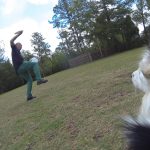 Out to the side of the handler is the Flank. If the dog is out to the handler's right or left the dog is on Flank. If the dog is moving with the... More to sweet interior moves. It’s not easy to do when the dog is coming in from the side or on an arc. Seamless transitions tend to happen with a set up move
Out to the side of the handler is the Flank. If the dog is out to the handler's right or left the dog is on Flank. If the dog is moving with the... More to sweet interior moves. It’s not easy to do when the dog is coming in from the side or on an arc. Seamless transitions tend to happen with a set up move Set Up Moves are tricks that are used to establish timing and position in disc dog freestyle. Traditional tricks include: Around, Through, Backwards Through, and Scoot, but any or all of your tricks,... More by the team or a screeching halt in Front
Set Up Moves are tricks that are used to establish timing and position in disc dog freestyle. Traditional tricks include: Around, Through, Backwards Through, and Scoot, but any or all of your tricks,... More by the team or a screeching halt in Front Front is a stable position directly in front of the handler. Front is an traditional obedience skill. Usually your dog sits in this position, but standing is often acceptable as well, especially in... More PositionIn the Play+ philosophy, "Position" is the final stage within the "Next" phase of a Cycle of Play. It acts as a pivotal link between the "Next" phase and a new "Now" phase. More by the dog.
Front is a stable position directly in front of the handler. Front is an traditional obedience skill. Usually your dog sits in this position, but standing is often acceptable as well, especially in... More PositionIn the Play+ philosophy, "Position" is the final stage within the "Next" phase of a Cycle of Play. It acts as a pivotal link between the "Next" phase and a new "Now" phase. More by the dog.
Flatwork can be used in close quarters to clearly communicate team movement and limit mistakes while set up happens on the move.
The Jakie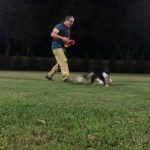 The Jakie is a trick where the dog intercepts the disc on the way to the handler's body and then uses the handler's body to safely and stylishly flip to land the trick.... More Twist, a flip off the handler’s body after catching a disc, is a great move for this. The angles work pretty well and there’s a well defined target to help the dog line up from awkward anglers.
The Jakie is a trick where the dog intercepts the disc on the way to the handler's body and then uses the handler's body to safely and stylishly flip to land the trick.... More Twist, a flip off the handler’s body after catching a disc, is a great move for this. The angles work pretty well and there’s a well defined target to help the dog line up from awkward anglers.
You should be able to see the flank slow roll into a pose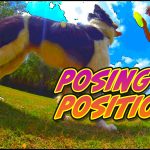 Posing is a communication tool for throwing discs to dogs (or people). A pose is a frozen moment of a throw; a key moment of the backswing perhaps, or a flashy presentation of... More (BSP – Basic Standing PositionStanding in front of the dog with the disc held vertically in the throwing hand is Basic Standing Position (BSP), a foundational position in the Yachi Method. More in Yachi MethodA Disc Dog handling system practiced by the Japanese USDDN contingent, developed by Yachi Hirai with the spirit and influence of Melissa Heeter and Pam Martin. More), the movement and pressure from the handler’s lower body, shoulders, and hands transitioning and halting the dog. It’s really pretty sweet.
Posing is a communication tool for throwing discs to dogs (or people). A pose is a frozen moment of a throw; a key moment of the backswing perhaps, or a flashy presentation of... More (BSP – Basic Standing PositionStanding in front of the dog with the disc held vertically in the throwing hand is Basic Standing Position (BSP), a foundational position in the Yachi Method. More in Yachi MethodA Disc Dog handling system practiced by the Japanese USDDN contingent, developed by Yachi Hirai with the spirit and influence of Melissa Heeter and Pam Martin. More), the movement and pressure from the handler’s lower body, shoulders, and hands transitioning and halting the dog. It’s really pretty sweet.
One of the most valuable things I learned at Yachi Camp is that the position I do Flatwork in is a Pose. It’s Basic Flank Position (BFP). 🙂 I figured this meant that I could seamlessly transition from Working Flank to Front Position any time I want it. And it did. The dogs are highly responsive to the Flank cue being a pose.
The key here is to transition from the Flank to the pose, from BFP to BSP. The pose before the interior trick is key as well. The dog needs to trust the Flatwork cues as they would a pose. If they do then Flatwork really does become applicable to interior movement.
Linking Some Other Stuff
Linking other tricks allows Epic and I to play around with this idea and to avoid turning the sequence into a simple pattern: Jakie circle Jakie. It is important that both Epic and I understand what we are doing and have more than muscle memory to rely on when things get crazy.
Many times, applying the skill or concept you are working on to a similar activity can really solidify the skill or the concept you are working on. Call it forced fluency.
Tightening Up the Jakie
Now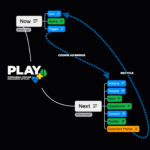 The Now Phase is an integral part of the Play Cycle in the Play+ training philosophy. It embodies the current, immediate interaction between the handler and the dog, anchoring them in the present... More that Epic and I kind of know what it is we are doing. We’ve got some experience with different angles, looks, and timing. We’ve tried a couple other tricks to generalize the idea of what it is we’re trying to do here.
The Now Phase is an integral part of the Play Cycle in the Play+ training philosophy. It embodies the current, immediate interaction between the handler and the dog, anchoring them in the present... More that Epic and I kind of know what it is we are doing. We’ve got some experience with different angles, looks, and timing. We’ve tried a couple other tricks to generalize the idea of what it is we’re trying to do here.
So let’s give it a shot. These are live speed moves, for the most part. And look how creative Epic got on that one that was sort of ‘flippy’.






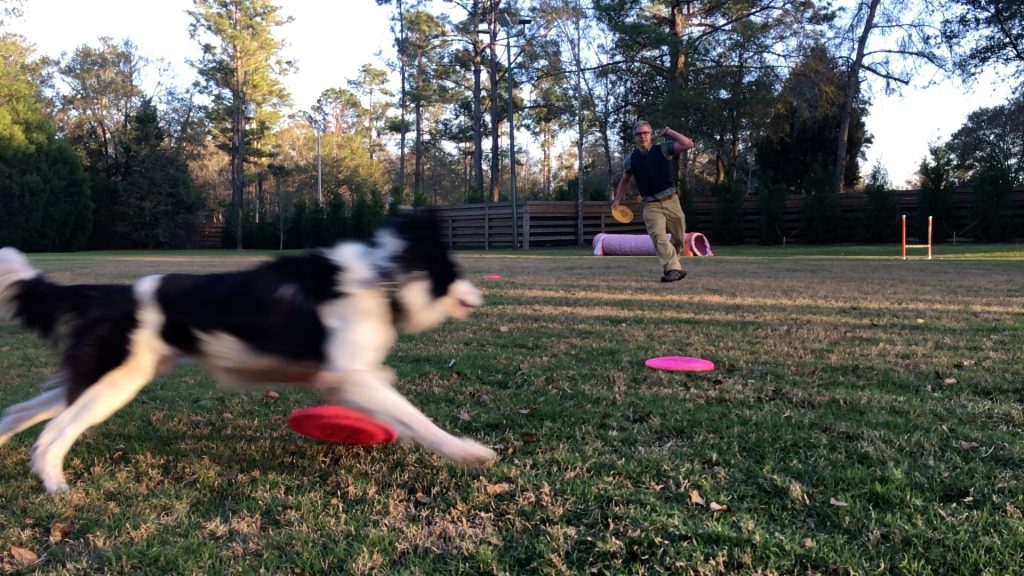
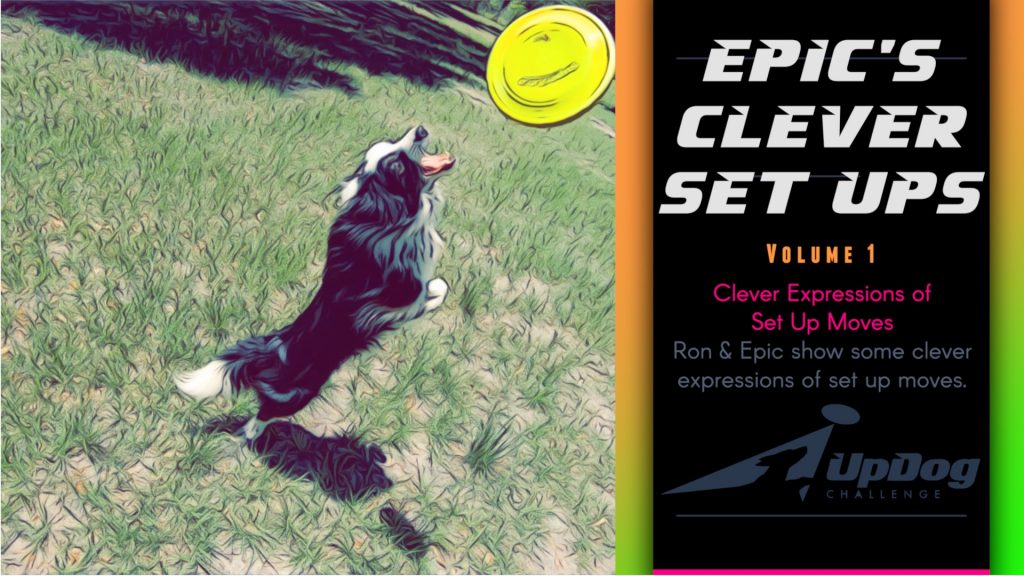
Responses